- Home
- Tom Clancy
Shadow Warriors: Inside the Special Forces sic-3 Page 3
Shadow Warriors: Inside the Special Forces sic-3 Read online
Page 3
Both elements would haunt the command in June 1985, just four months before the events aboard the Achille Lauro.
TWA 847
On Friday, June 14, 1985, at 10:00 A.M. local time, TWA Flight 847 took off from Athens Airport headed for Rome, with 153 passengers and crew on board, 135 of whom were American. The plane, a relatively short-range Boeing 727, was piloted by Captain John Testrake; its copilot was First Officer Phillip Marsca; and Christian Zimmerman was the flight engineer.
According to information later provided by Greek authorities, the day before three young men in their twenties had traveled from Beirut to Athens, spent the night in the Athens terminal, and then tried to make reservations on the Athens-to-Rome leg of Flight 847. Their intent: to hijack the aircraft. It was a full flight, however, and only two of them, traveling under the code names Castro and Said (and later identified as Mohamed Ali Hamadi and Hassan Izz-al-din), were able to get seats. The one who had to stay behind in Athens would later be identified as Ali Atwa, and held by Greek authorities, as soon as his part in the hijack became known. The three of them, as it now seems, belonged to Hezbollah, a radical, revolutionary, terrorist faction with ties to Iran. The hijack was a Hezbollah operation, though other factions active in Lebanon would also make their presence felt as the event played out.
Once they were on board, Castro and Said took seats in the rear of the plane near the lavatory, where the weapons used in the hijacking had been stashed, most likely by airport employees. One of them took a small carry-on bag into the lavatory and secured the weapons — two pistols and hand grenades.
As soon as the plane reached flight altitude, the two terrorists went into action. They leapt from their seats and ran to the front of the plane. When they got there, they pushed the flight attendant, Uli Derickson, to the floor, screaming all the while in Arabic and broken English, "Come to die. Americans die." They then tried to make their presence known to the cockpit crew by knocking Uli Derickson's head against the cockpit door. After they'd shoved a grenade in her face and a gun in her car, she somehow managed to get to the intercom and inform Christian Zimmerman that a hijacking was taking place.
Captain Testrake immediately ordered the door of the cabin to be opened, and the two hijackers shouted their first demand: They wanted to go to Algeria.
This was not possible. The 727 didn't have enough fuel on board, so the Captain recommended Cairo instead. This suggestion made the already jumpy terrorists even more upset. "If not Algeria, then Beirut, they shouted. "Fuel only."
Captain Testrake changed course and headed toward Beirut, which was seven hundred miles away and only just barely within range.
Meanwhile, Castro ordered all the passengers in the first-class section to move to the rear of the airplane. Since there were not enough seats available, some of them were forced to sit with other passengers. He then directed Uli Derickson to gather all the passports so he could tell which passengers were American and/or Jewish. Once the passports had been collected, Castro ordered Uli to pick out the Israelis, but it turned out that no Israelis were aboard. He then told her to select the Jews, but that also proved impossible, since American passports do not show religion. Growing more impatient, he had her read the passenger list for him. When she came to what sounded like a Jewish name, he ordered her to find that passenger's passport. Seven people fit this category.
Castro next shifted his attention to military ID cards (servicemen usually travel on their ID cards rather than passports). Aboard the plane were an Army reservist named Kurt Karlson and six Navy divers returning from an underwater job in Greece. Castro and Said forced the divers to move to widely separated seats, yelling, "Marines! The New Jersey!" The battleship New Jersey had recently fired on Beirut, and 1,500 Marines had been stationed at the Beirut airport.
Then Castro ordered all passengers to sit with their heads between their legs without looking up.
When TWA 847 reached the Beirut area, it was very low on fuel. Even so, Beirut control denied the aircraft permission to land. Since this did not please the hijackers, one of them, who was in the cockpit at the time, pulled the pin of a hand grenade and threatened to blow up the airliner. Captain Testrake decided he had no choice but to bluff his way in.
That worked, and they were able to set down safely and park. They then waited for refueling. The terrorists still intended to fly to Algeria.
As they touched down, the cockpit crew couldn't help but notice the wreckage of a Jordanian airliner blown up two days earlier by the PLO.
Because the Lebanese were far from eager to get involved in the ongoing crisis, they ignored the request for fuel. That meant that the terrorists were again displeased. To make clear their determination, they tightly bound the hands of Navy diver Robert Stethem with a bungee cord, dragged him to the front of the airplane, beat him savagely enough to break all his ribs, then dumped him moaning and bleeding in a seat near the front of the plane.
When the captain radioed the tower, "They are beating the passengers and threatening to kill them!" the Lebanese authorities were persuaded to send a refueling truck to TWA 847.
Because it was a long flight to Algeria, Testrake had to take on all the fuel the plane could hold, making the plane some 15,000 pounds overweight with a full load of passengers — and unsafe for takeoff. In view of that, the hijackers agreed to let seventeen women and two children go (they left by sliding down the emergency escape chutes). Releasing the passengers not only made the plane safer, it reduced the number of people that the hijackers had to control — and provided access to a source of intelligence about what was happening on the plane.
Predictably, considering the delay and indecision that marked the whole sequence of events, it was several hours before the released passengers could be flown to Cyprus, a hundred miles away, where they could be interviewed in detail by American officials.
Meanwhile, word of the hijacking did not reach Washington officials until about 4:00 A.M., Washington time. JSOTF learned of it shortly thereafter, from news reports picked up by its Reuters and BBC monitors. Crisis-management teams started gathering at the Federal Aviation Administration, the Pentagon, the State Department, and the White House Situation Room, but none of them had more than sketchy details.
At 6:30 Friday morning, Washington time, TWA 847 cleared the runway in Beirut and headed for Algeria, 1,800 miles away.
By that time the gears in Washington had started to grind into motion. The Pentagon had been ready to respond immediately — it operates twenty-four hours a day — but no one with sufficient rank to make a decision had been available at the White House or State Department. The Administration's terrorist incident working group did not meet until approximately 10:00 that morning.
Meanwhile, at Fort Bragg, JSOTF had already alerted its own forces in anticipation that Americans could be on board the hijacked aircraft, as well as the Military Airlift Command, since lift assets would be needed soon, and the J-3 (Operations) officer of the Joint Chiefs of Staff, requesting Pentagon authority for immediate deployment. The forces that would take part in the operation would come primarily from Army Special Forces and an Army special operations helicopter unit. They expected to fly first to Sigonella, a NATO base on Sicily operated jointly by the United States and Italy, and therefore strategically located at the midpoint of the Mediterranean.
Since only two lightly armed terrorists were in charge of the airplane, excellent conditions existed for a takedown — if, as seemed to be the case, Algeria was in fact TWA 847's destination, and if it was possible to persuade the Algerians to hold the plane on the ground.
With this scenario in mind, JSOTF requested USEUCOM (European Command) to authorize two C-13 °Combat Talon aircraft, capable of low-level flight and landing in total darkness to be prepared to deploy from Mildenhall, England, to Sigonella. JSOTF had additionally requested another TWA Boeing 727, identical to the hijacked aircraft, to join the Task Force at Sigonella.
Since JSOTF maintained a detaile
d database covering every airfield in those regions of the world where terrorist incidents were likely to take place, it was aware of all the characteristics of the Algerian airfield to which the hijacked plane would most likely head. Thus JSOTF had two takedown options: Combat Talon aircraft carrying the rescue force could land blacked out at night. Or the second TWA 727 could be used as a Trojan horse.
All the while, valuable time was being wasted. The Force had been ready to go soon after learning of the hijacking but, as was the case in the past and as would be the case later that year in October, neither airlift nor crews qualified to fly these missions were available. Rounding them up consumed valuable time… time the terrorists used most efficiently to stay ahead of JSOTF's reaction time.
When the Administration's terrorist incident working group finally met on Friday morning, they recommended that the Task Force be dispatched immediately.
If airlift had been readily available, Stiner and his forces (including the Combat Talons from England and the TWA 727) could have been arriving at Sigonella at about the time TWA 847 was approaching Algeria. However, the Pentagon was reluctant to launch the Task Force until TWA 847 settled down wherever it was going.
By midday Algerian time, during (as it happened) the Muslim holy season of Ramadan, TWA 847 was approaching Algeria.
While en route there, Castro made a broadcast in Arabic over the plane's radio, detailing the terrorists' demands: He wanted more than seven hundred Shiites released from prison in Israel, seventeen other Shiites freed from a prison in Kuwait, two other Shiites released from Spain, and two others from Cyprus. Additionally, he wanted Israel to withdraw from southern Lebanon, the United States to admit responsibility for a recent car bombing in Beirut, and the world to condemn America for its support of Israel.
These demands were, of course, impossible to meet.
As the aircraft was approaching the airfield in Algeria, the State Department passed on to Ambassador Michael Newlin a directive from President Reagan: He was to contact Algerian president Chadli Benjedid and make two requests: first, to make an exception to Algeria's policy that hijacked aircraft not be allowed to land; and second, to keep the plane on the ground and not permit it to take off again after landing.
Looking back over the entire TWA 847 affair, it is possible to see that the United States had only one real opportunity to rescue the hostages without high risk of bloodshed. It was during that first stopover in Algeria. That opportunity was blown, however.
Instead of doing everything in his power to make direct contact with President Benjedid, as he'd been instructed, Michael Newlin settled for subordinates, and then he allowed the Algerian subordinates to pretty much call the shots.
As he later reported, most of his own staff was unavailable (having already taken off to Mediterranean beaches for the weekend), and he found few members of the Algerian government who would take his calls. Newlin did manage to get hold of Benjedid's chief of staff, however, and forty-five minutes later, he called back to say that TWA 847 would be permitted to land "on humanitarian grounds."
By this time, TWA 847 was already requesting permission to land, and had less than thirty minutes of fuel remaining.
After landing, the terrorists decided to return to Beirut to pick up reinforcements, causing another problem with refueling, which meant that another American serviceman, Army Reservist Kurt Karlson, was beaten. Again, though, that facilitated matters (though the flight attendant, Uli Derickson, had to pay for the fuel with her Shell credit card, since TWA didn't have landing facilities in Algeria; she was later billed for six thousand gallons of jet fuel at a dollar a gallon). On the other hand, the terrorists released another twenty-one passengers — eighteen of them American.
Once the refueling was completed, TWA 847 took off again and headed back toward Beirut. The Algerian government made no move to hold the plane on the ground.
Meanwhile, an Air Force C-141 was launching from Andrews AFB just outside Washington, D.C., with the twenty-man Emergency Support Team (EST), headed by a senior State Department official, Ambassador David Long. Joining him were a senior CIA official (formerly a senior station chief), representatives from the Defense Intelligence Agency, communications and technical personnel, selected members of the White House National Security Staff, and a couple of senior Special Forces officers who would act in an advisory and coordination role. The EST's mission was to precede the Task Force, assist the Ambassador and his staff, and interface with JSOTF, the State Department, and National Intelligence Agencies. After some indecision about the best place to go, the team decided to land at Sigonella.
It was after 2:00 in the morning when TWA 847 began its approach for its second landing in Beirut.
The runway marker lights were out. The airport was blacked out. Once again the Beirut control tower refused permission to land, and once again Captain Testrake was desperate: "I have no more than twenty minutes of fuel left," he explained to the tower. "I'm coming in even if it means landing next to the runway."
When Testrake broke out of the clouds 500 feet above the airport, he could see vehicles blocking the runway. He radioed to the tower: "We're in deadly danger. I implore you to open your airport and let us land."
The controller replied, "Unfortunately, my superiors do not care about your problems."
"If we try to land, we'll crash," Testrake told the hijackers.
"Good," one answered. "That will save us the trouble of blowing it up."
"Prepare the passengers for a crash landing," Testrake told Uli Derickson. He then made an announcement to the passengers: "We are low on fuel and have to land. We have fuel for only one approach. We're going in. Prepare for a crash landing. If they do not remove the obstacles, we will land on the ground beside the runway. Otherwise, we will have to land in the water."
But with three miles to go, the runway lights flashed on, the vehicles were removed, and the tower told Testrake he was clear to land.
Another gut-cruncher…. These were getting to be a habit.
Once the aircraft was on the ground, the hijackers ordered Testrake to stop in the middle of the runway, far from any buildings. Castro and Said then began talking to the tower in Arabic, their voices increasingly angry. They were demanding that reinforcements be allowed to board the plane, and the Lebanese authorities were resisting their demands.
"I don't want to talk to you," one of them screamed at the controller. "I only talk to the Amal." Amal was an armed Shiite faction in Beirut, headed by a lawyer named Nhabbi Barri, with ties to Syrian president Hafez Assad. Amal was somewhat more moderate than Hezbollah. As later became apparent, Assad was working behind the scenes with Amal and Hezbollah's Iranian masters to resolve the situation, but on terms that would be to his political advantage.
"You arc trying to gain time," the terrorist continued. "You don't believe me. We'll kill this Marine." He meant Robert Stethem, the Navy diver who had been beaten during the first landing in Beirut.
Castro then dragged Stethem, screaming in agony, to the open door of the aircraft, placed a pistol to the back of his head, and fired. Then he dumped his body onto the tarmac.
"He has just killed a passenger," the pilot reported.
As he spoke, Castro snatched the microphone and said, "You see. You now believe. There will be another in five minutes."
At this point, Castro ordered Testrake to taxi to the refueling points.
The terrorists never forgot that time was precious. The longer they stayed in one place, the greater the window for a takedown attempt. Thus they bounced back and forth from one place to the other.
"As I began moving down the runway," Testrake later remembered, "I turned the wheel sharply to avoid running over the young serviceman's body."
As all this was going on, everyone on the plane had fallen silent — horrified at the violence — until one of the terrorists started singing a song. "It was a song of celebration," Uli Derickson recalled.
Meanwhile, the terrorists chose
their next victim: Clinton Suggs, another Navy diver.
"The hijacker came back where 1 was," Suggs recalled, "and he was kicking me and hitting me and calling me American pig. I thought I was dead. I prayed and asked the Lord to receive me in his arms."
All of a sudden, the back door of the plane opened and ten or twelve heavily armed militiamen carrying automatic weapons rushed onto the plane, screaming and shouting. The terrorists had succeeded in getting their reinforcements… and multiplying the difficulty of a takedown.
One of the twelve, who identified himself as Gihad and spoke fluent English, was in fact one of Lebanon's leading terrorists, Imad Mugniyah. Mugniyah had once been a member of Amal, but at this time he was with Hezbollah — their "enforcer." Muginayah now took charge of the operation.
After the aircraft was refueled, six Americans, including Kurt Karlson, Clinton Suggs, and three other Navy divers, were ordered into seats in the last two rows of the plane. Shortly after that, the six were rushed down the back steps of the plane into a waiting enclosed truck. A few moments later, a second group of five passengers — another Navy diver and four of the seven with Jewish-sounding names — were also taken off the plane, loaded into another truck, and whisked away.
Flight 847 then took off again, headed for Algeria. This second Algerian episode would last until Sunday.
It was now daybreak Saturday.
Robert Stethem's body had already been dumped on the tarmac in Beirut before Carl Stiner was given authority to launch with his JSOTF. Six to eight more hours of flying time were required before they could be in position to resolve the situation.
While Stiner was en route, the State Department had directed Ambassador Newlin to ask the Algerians for permission to bring in Long's EST, who by then had reached Sigonella.

 Changing of the Guard
Changing of the Guard Clear and Present Danger
Clear and Present Danger Hounds of Rome
Hounds of Rome Breaking Point
Breaking Point Tom Clancy's Jack Ryan Books 7-12
Tom Clancy's Jack Ryan Books 7-12 Full Force and Effect
Full Force and Effect The Archimedes Effect
The Archimedes Effect Combat Ops
Combat Ops Into the Storm: On the Ground in Iraq
Into the Storm: On the Ground in Iraq Under Fire
Under Fire Point of Impact
Point of Impact Red Rabbit
Red Rabbit Rainbow Six
Rainbow Six The Hunt for Red October
The Hunt for Red October The Teeth of the Tiger
The Teeth of the Tiger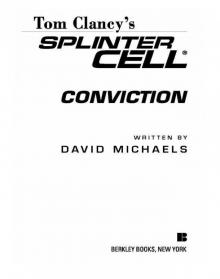 Conviction (2009)
Conviction (2009) Battle Ready
Battle Ready Patriot Games
Patriot Games The Sum of All Fears
The Sum of All Fears Fallout (2007)
Fallout (2007) Red Storm Rising
Red Storm Rising The Cardinal of the Kremlin
The Cardinal of the Kremlin Executive Orders
Executive Orders Lincoln, the unknown
Lincoln, the unknown Threat Vector
Threat Vector The Hunted
The Hunted Shadow Warriors: Inside the Special Forces
Shadow Warriors: Inside the Special Forces End Game
End Game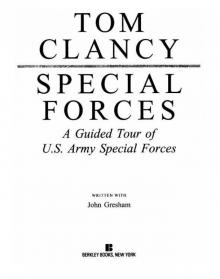 Special Forces: A Guided Tour of U.S. Army Special Forces
Special Forces: A Guided Tour of U.S. Army Special Forces Locked On
Locked On Line of Sight
Line of Sight Tom Clancy Enemy Contact - Mike Maden
Tom Clancy Enemy Contact - Mike Maden Fighter Wing: A Guided Tour of an Air Force Combat Wing
Fighter Wing: A Guided Tour of an Air Force Combat Wing Springboard
Springboard Line of Sight - Mike Maden
Line of Sight - Mike Maden EndWar
EndWar Dead or Alive
Dead or Alive Tom Clancy Support and Defend
Tom Clancy Support and Defend Checkmate
Checkmate Command Authority
Command Authority Carrier: A Guided Tour of an Aircraft Carrier
Carrier: A Guided Tour of an Aircraft Carrier Blacklist Aftermath
Blacklist Aftermath Marine: A Guided Tour of a Marine Expeditionary Unit
Marine: A Guided Tour of a Marine Expeditionary Unit Commander-In-Chief
Commander-In-Chief Armored Cav: A Guided Tour of an Armored Cavalry Regiment
Armored Cav: A Guided Tour of an Armored Cavalry Regiment Tom Clancy's Jack Ryan Books 1-6
Tom Clancy's Jack Ryan Books 1-6 The Ultimate Escape
The Ultimate Escape Airborne: A Guided Tour of an Airborne Task Force
Airborne: A Guided Tour of an Airborne Task Force Debt of Honor
Debt of Honor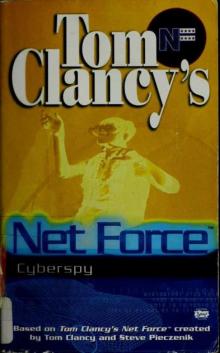 Cyberspy
Cyberspy Point of Contact
Point of Contact Operation Barracuda (2005)
Operation Barracuda (2005) Choke Point
Choke Point Power and Empire
Power and Empire Every Man a Tiger: The Gulf War Air Campaign
Every Man a Tiger: The Gulf War Air Campaign Endgame (1998)
Endgame (1998) EndWar: The Missing
EndWar: The Missing Splinter Cell (2004)
Splinter Cell (2004) The Great Race
The Great Race True Faith and Allegiance
True Faith and Allegiance Deathworld
Deathworld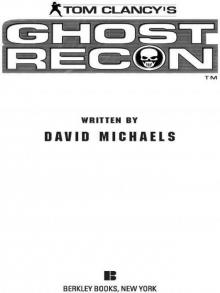 Ghost Recon (2008)
Ghost Recon (2008) Duel Identity
Duel Identity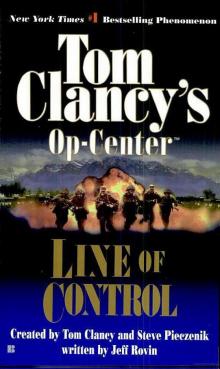 Line of Control o-8
Line of Control o-8 The Hunt for Red October jr-3
The Hunt for Red October jr-3 Hidden Agendas nf-2
Hidden Agendas nf-2 Acts of War oc-4
Acts of War oc-4 Ruthless.Com pp-2
Ruthless.Com pp-2 Night Moves
Night Moves The Hounds of Rome - Mystery of a Fugitive Priest
The Hounds of Rome - Mystery of a Fugitive Priest Into the Storm: On the Ground in Iraq sic-1
Into the Storm: On the Ground in Iraq sic-1 Threat Vector jrj-4
Threat Vector jrj-4 Combat Ops gr-2
Combat Ops gr-2 Virtual Vandals nfe-1
Virtual Vandals nfe-1 Runaways nfe-16
Runaways nfe-16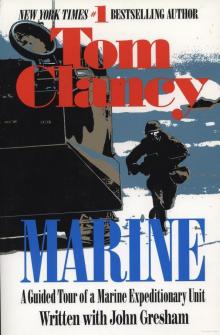 Marine: A Guided Tour of a Marine Expeditionary Unit tcml-4
Marine: A Guided Tour of a Marine Expeditionary Unit tcml-4 Shadow Warriors: Inside the Special Forces sic-3
Shadow Warriors: Inside the Special Forces sic-3 Jack Ryan Books 1-6
Jack Ryan Books 1-6 Cold Case nfe-15
Cold Case nfe-15 Changing of the Guard nf-8
Changing of the Guard nf-8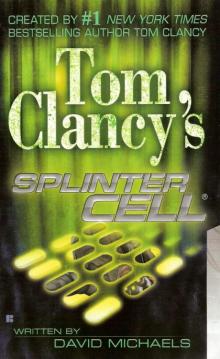 Splinter Cell sc-1
Splinter Cell sc-1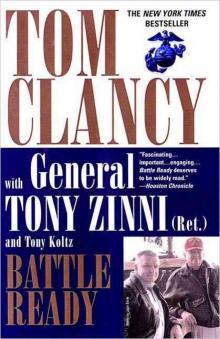 Battle Ready sic-4
Battle Ready sic-4 The Bear and the Dragon jrao-11
The Bear and the Dragon jrao-11 Fighter Wing: A Guided Tour of an Air Force Combat Wing tcml-3
Fighter Wing: A Guided Tour of an Air Force Combat Wing tcml-3 Patriot Games jr-1
Patriot Games jr-1 Jack Ryan Books 7-12
Jack Ryan Books 7-12 Mission of Honor o-9
Mission of Honor o-9 Private Lives nfe-9
Private Lives nfe-9 Operation Barracuda sc-2
Operation Barracuda sc-2 Cold War pp-5
Cold War pp-5 Point of Impact nf-5
Point of Impact nf-5 Red Rabbit jr-9
Red Rabbit jr-9 The Deadliest Game nfe-2
The Deadliest Game nfe-2 Springboard nf-9
Springboard nf-9 Safe House nfe-10
Safe House nfe-10 EndWar e-1
EndWar e-1 Duel Identity nfe-12
Duel Identity nfe-12 Deathworld nfe-13
Deathworld nfe-13 Politika pp-1
Politika pp-1 Rainbow Six jr-9
Rainbow Six jr-9 Tom Clancy's Power Plays 1 - 4
Tom Clancy's Power Plays 1 - 4 Endgame sc-6
Endgame sc-6 Executive Orders jr-7
Executive Orders jr-7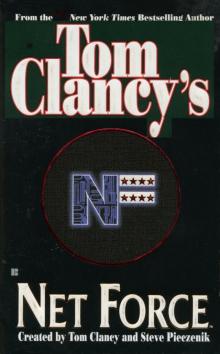 Net Force nf-1
Net Force nf-1 Call to Treason o-11
Call to Treason o-11 Locked On jrj-3
Locked On jrj-3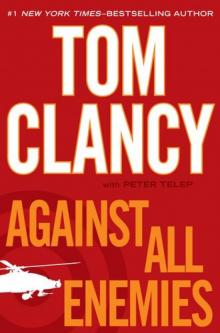 Against All Enemies
Against All Enemies The Sum of All Fears jr-7
The Sum of All Fears jr-7 Sea of Fire o-10
Sea of Fire o-10 Fallout sc-4
Fallout sc-4 Balance of Power o-5
Balance of Power o-5 Shadow Watch pp-3
Shadow Watch pp-3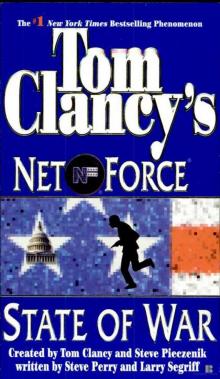 State of War nf-7
State of War nf-7 Wild Card pp-8
Wild Card pp-8 Games of State o-3
Games of State o-3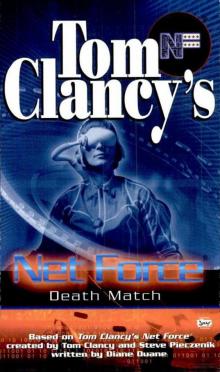 Death Match nfe-18
Death Match nfe-18 Against All Enemies mm-1
Against All Enemies mm-1 Every Man a Tiger: The Gulf War Air Campaign sic-2
Every Man a Tiger: The Gulf War Air Campaign sic-2 Cybernation nf-6
Cybernation nf-6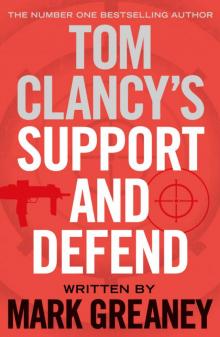 Support and Defend
Support and Defend Night Moves nf-3
Night Moves nf-3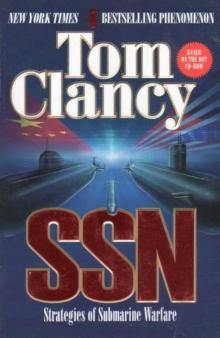 SSN
SSN Cutting Edge pp-6
Cutting Edge pp-6 The Cardinal of the Kremlin jrao-5
The Cardinal of the Kremlin jrao-5 War of Eagles o-12
War of Eagles o-12 Op-Center o-1
Op-Center o-1 Mirror Image o-2
Mirror Image o-2 The Archimedes Effect nf-10
The Archimedes Effect nf-10 Teeth of the Tiger jrj-1
Teeth of the Tiger jrj-1 Bio-Strike pp-4
Bio-Strike pp-4 State of Siege o-6
State of Siege o-6 Debt of Honor jr-6
Debt of Honor jr-6 Zero Hour pp-7
Zero Hour pp-7 Ghost Recon gr-1
Ghost Recon gr-1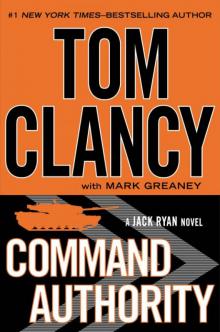 Command Authority jr-10
Command Authority jr-10 Tom Clancy's Power Plays 5 - 8
Tom Clancy's Power Plays 5 - 8 Checkmate sc-3
Checkmate sc-3 Breaking Point nf-4
Breaking Point nf-4 Gameprey nfe-11
Gameprey nfe-11 The Hunted e-2
The Hunted e-2 Hidden Agendas
Hidden Agendas Divide and Conquer o-7
Divide and Conquer o-7